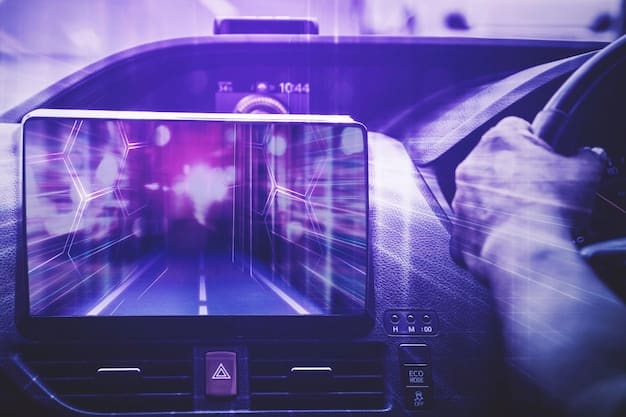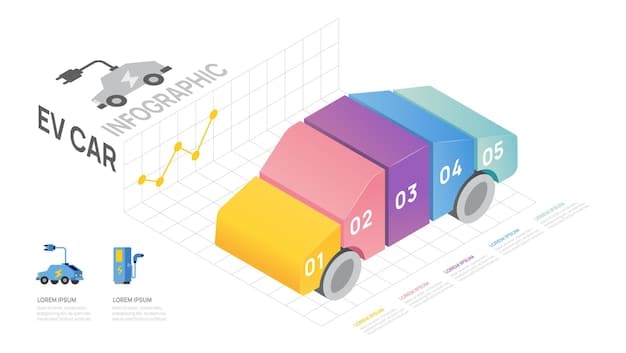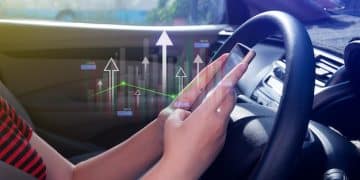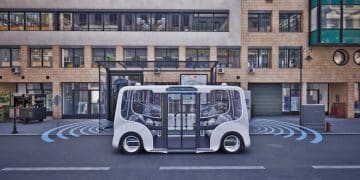Decoding Level 3 Autonomous Driving: A Guide for US Drivers

Decoding Autonomous Driving Levels: What Does Level 3 Really Mean for US Drivers? Level 3 autonomous driving represents a significant leap, allowing conditional automation where the car handles most driving tasks, but the driver must be ready to intervene when prompted in specific, limited scenarios.
The world of autonomous driving is rapidly evolving, and understanding the different levels can be confusing. Let’s dive into decoding autonomous driving levels: what does Level 3 really mean for US drivers?, exploring its capabilities, limitations, and what it means for the future of driving.
Understanding the Basics of Autonomous Driving Levels
Before we focus specifically on Level 3, it’s important to understand the broader context of autonomous driving levels. These levels, defined by SAE International, provide a standardized way to classify the degree of automation in vehicles. Understanding this scale is crucial for assessing the capabilities and limitations of different autonomous systems.
From Level 0 (no automation) to Level 5 (full automation), each level represents a different degree of driver assistance and vehicle autonomy. Let’s briefly break down each level before delving into Level 3.
The Six Levels of Driving Automation
The SAE (Society of Automotive Engineers) defines six levels of driving automation, from 0 to 5. Each level indicates the extent to which a vehicle can perform driving tasks without human input.
- Level 0: No Automation: The driver controls everything. There are no automated features, though there may be warning or intervention systems.
- Level 1: Driver Assistance: The vehicle offers limited assistance, such as adaptive cruise control or lane keeping assist. The driver must remain fully engaged and monitor the driving environment.
- Level 2: Partial Automation: The vehicle can control steering and acceleration/deceleration in certain situations. The driver must still monitor the driving environment and be prepared to take control at any time. Examples include Tesla’s Autopilot (with limitations) and Cadillac’s Super Cruise.
- Level 3: Conditional Automation: The vehicle can perform all driving tasks in certain conditions, but the driver must be ready to intervene when the system requests. This is where things get more complex, as we’ll explore in depth.
- Level 4: High Automation: The vehicle can perform all driving tasks in certain conditions without driver intervention. However, the system may have operational design domains (ODDs) where it cannot function.
- Level 5: Full Automation: The vehicle can perform all driving tasks in all conditions. No driver is required. This is the ultimate goal of autonomous driving.
Understanding these levels provides a framework for evaluating the capabilities of different autonomous systems. Level 3 represents a significant jump in autonomy, but it also comes with unique challenges.

Level 3: Conditional Automation Explained
Level 3 autonomous driving is characterized by conditional automation. This means the vehicle can handle most driving tasks under specific circumstances, reducing the need for constant driver attention. However, this also introduces the critical element of the “handoff,” where the system requests the driver to take control.
This level differs from Level 2 in that the driver is not expected to monitor the driving environment continuously when the system is engaged. Instead, the driver can perform other tasks, such as reading or watching a movie, until the system prompts them to take over.
Key Features of Level 3 Systems
Level 3 systems are equipped with sophisticated sensors, powerful processors, and advanced software algorithms that enable them to perceive and react to the driving environment.
- Environmental Awareness: Uses a combination of cameras, radar, and lidar to create a detailed 3D map of the surroundings.
- Decision-Making: Employs AI algorithms to process sensor data, make decisions, and control the vehicle.
- Fallback Mechanisms: Designed to safely handle system failures or unexpected events.
These features allow Level 3 systems to operate autonomously in specific situations, such as highway driving with clear lane markings and minimal traffic.
The Challenges of Level 3 Automation
Despite its advancements, Level 3 automation faces significant challenges. One of the biggest hurdles is the “handoff” process, where the system transfers control back to the driver. This transition can be problematic, especially if the driver is not immediately ready to take over.
Another challenge is ensuring the system can handle a wide range of driving scenarios and unexpected events. While Level 3 systems are designed to operate in specific conditions, they may encounter situations they are not programmed to handle.
Handoff Issues
The handoff from the automated system back to the driver is a critical aspect of Level 3 automation. It needs to be seamless and give the driver sufficient time to regain situational awareness.
- Driver Readiness: Ensuring the driver is alert and capable of taking control when prompted.
- Transition Time: Providing enough time for the driver to assess the situation and react appropriately.
- System Reliability: Minimizing false positives and unnecessary handoffs.
These issues need to be addressed to ensure the safety and reliability of Level 3 systems.
Level 3 in the US Market: Current Status
As of now, Level 3 autonomous driving is not widely available in the United States. Regulatory hurdles and concerns about safety have slowed its adoption. However, some automakers are making progress in developing and testing Level 3 systems.
Several manufacturers, including Mercedes-Benz and Audi, have demonstrated Level 3 capabilities in specific models. However, the availability of these systems is currently limited to certain regions and under strict conditions.
Regulatory Landscape
The regulatory environment for autonomous driving is still evolving in the US. Different states have varying laws and regulations regarding self-driving vehicles.
Federal guidelines also play a crucial role in shaping the development and deployment of autonomous systems. The National Highway Traffic Safety Administration (NHTSA) is responsible for setting safety standards and regulations for vehicles in the US.
What Level 3 Means for US Drivers
The introduction of Level 3 autonomous driving has significant implications for US drivers. It promises to reduce driver workload and make long trips more comfortable. However, it also raises important questions about liability, safety, and driver behavior.
With Level 3 systems, drivers can potentially engage in non-driving activities, such as reading or working, while the vehicle handles the driving tasks. This can lead to increased productivity and reduced stress during commutes.

Benefits of Level 3 Automation
Level 3 automation offers several potential benefits for drivers, including:
- Reduced Driver Workload: The system handles most driving tasks, allowing the driver to relax and engage in other activities.
- Increased Comfort: Long trips become more comfortable and less tiring.
- Potential for Increased Productivity: Drivers can use their commute time for work or other productive activities.
These benefits could transform the way we travel and commute, making driving a more enjoyable and efficient experience.
The Future of Autonomous Driving: Beyond Level 3
While Level 3 represents a significant step forward, it is not the ultimate goal of autonomous driving. The industry is continuously working towards higher levels of automation, with the ultimate goal of achieving Level 5, or full autonomy.
Level 4 and Level 5 systems promise to offer even greater convenience and safety, eliminating the need for human intervention in most driving scenarios. However, these levels also present significant technological and regulatory challenges.
The Path to Full Autonomy
Achieving full autonomy will require further advancements in sensor technology, AI algorithms, and regulatory frameworks. It will also require addressing ethical and societal concerns related to self-driving vehicles.
- Improved Sensor Capabilities: Developing more accurate and reliable sensors that can operate in all weather conditions.
- Advanced AI Algorithms: Creating AI algorithms that can handle complex driving scenarios and make real-time decisions.
- Robust Cybersecurity Measures: Protecting autonomous systems from hacking and cyber threats.
Overcoming these challenges will pave the way for a future where autonomous vehicles are commonplace on our roads.
| Key Point | Brief Description |
|---|---|
| 🚦 Level 3 Definition | Conditional automation where the car drives, but the driver must be ready to take over. |
| ⚠️ Handoff Challenge | The transition from autonomous mode back to driver control can be problematic. |
| ⚖️ Regulatory Status | Level 3 availability in the US is limited due to regulatory and safety concerns. |
| 🚀 Future Goals | The industry is working towards higher automation levels (4 & 5) for full autonomy. |
FAQ
In Level 2, the driver must constantly monitor the driving environment. In Level 3, the driver can disengage and perform other tasks, but must be ready to take control when prompted by the system.
Level 3 autonomous cars are not widely available for purchase in the US due to regulatory hurdles and safety concerns. Some manufacturers have demonstrated the technology, but availability is limited.
The system is designed to alert the driver and request them to take control. If the driver does not respond, the system should initiate a safe fallback procedure, such as slowing down and stopping the vehicle.
The legal implications are complex and depend on the specific circumstances of the accident. It could involve the driver, the manufacturer, or the technology provider. Clear regulations and guidelines are needed to address liability issues.
Advancements in sensor technology, AI algorithms, and cybersecurity measures are needed. Additionally, regulatory frameworks and public acceptance are crucial for the widespread adoption of higher levels of automation.
Conclusion
Decoding autonomous driving levels: what does Level 3 really mean for US drivers? It represents a transition to conditional automation, offering both potential benefits and challenges. While full-scale deployment in the US is still on the horizon, understanding its capabilities and limitations is crucial as we move towards a future where autonomous vehicles become more prevalent.




